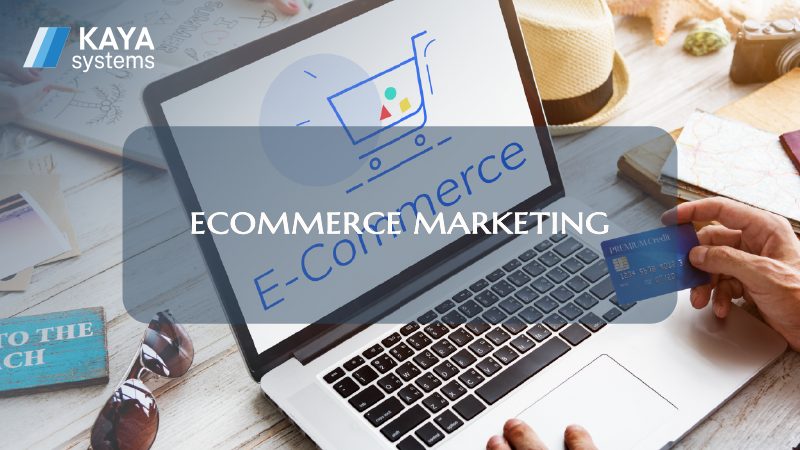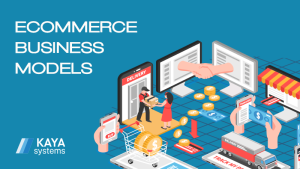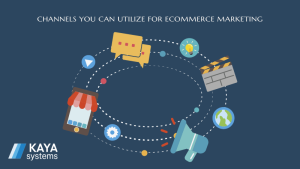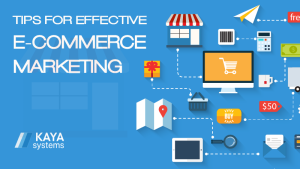
Ecommerce marketing refers to the strategies and tactics employed by businesses to promote and sell their products or services online. With the rise of the internet and the increasing popularity of online shopping, ecommerce marketing has become a vital component of any successful online business.
The primary goal of ecommerce marketing is to drive targeted traffic to an online store, convert visitors into customers, and encourage repeat purchases. It involves a range of activities such as search engine optimization (SEO), content marketing, social media marketing, email marketing, paid advertising, influencer marketing, and conversion rate optimization.
Ecommerce Business Models

1- Business-to-Consumer (B2C) Model
The B2C ecommerce model is the most common and widely recognized model. It involves businesses selling products or services directly to individual consumers through an online platform. The company owns and manages the entire ecommerce process, from sourcing products to handling transactions and logistics. Examples of B2C ecommerce businesses include online retailers like Amazon and clothing brands that sell directly to customers through their websites.
2- Business-to-Business (B2B) Model
In the B2B ecommerce model, businesses sell products or services to other businesses. This model is often characterized by larger order volumes and longer-term contracts. B2B transactions typically involve negotiations, customized pricing, and personalized solutions tailored to the specific needs of business customers. Examples of B2B ecommerce businesses include wholesale suppliers, manufacturers, and software providers offering enterprise solutions.
3- Consumer-to-Consumer (C2C) Model
The C2C e-commerce model facilitates transactions between individual consumers. It enables individuals to sell products or services directly to other consumers through online platforms, usually in a peer-to-peer fashion. These platforms act as intermediaries, providing a marketplace for individuals to list, buy, and sell items. Popular examples of C2C ecommerce platforms include eBay and Craigslist, where individuals can sell used items, handmade goods, and services to other consumers.
4- Consumer-to-Business (C2B) Model
The C2B e-commerce model is the opposite of the traditional B2C model. It occurs when individual consumers offer products or services to businesses. This model is often seen in freelancing or gig economy platforms where individuals provide specialized skills or expertise to businesses on a project or contract basis. For example, freelance writers, designers, or consultants offering their services to businesses through platforms like Upwork or Fiverr operate on the C2B model.
It’s worth noting that some ecommerce businesses may also adopt hybrid models or combinations of these primary models to suit their specific business needs. Additionally, subscription-based models, affiliate marketing models, and dropshipping models are also prevalent in the ecommerce industry, offering alternative ways for businesses to generate revenue and facilitate online transactions.
Channels You Can Utilize for Ecommerce Marketing

There are several channels that you can utilize for ecommerce marketing to reach and engage with your target audience. Here are some of the key channels:
Search Engine Optimization (SEO):
Optimizing your website for search engines is crucial for driving organic traffic. Focus on keyword research, optimizing on-page elements, creating high-quality content, and earning backlinks to improve your search engine rankings.
Pay-Per-Click Advertising (PPC)
PPC advertising allows you to display ads on search engine results pages or other websites and pay only when a user clicks on your ad. Platforms like Google Ads and Bing Ads offer robust targeting options and analytics to maximize your ROI.
Social Media Marketing
Utilize popular social media platforms such as Facebook, Instagram, Twitter, and LinkedIn to build brand awareness, engage with your audience, and drive traffic to your ecommerce website. Create compelling content, run targeted ads, and leverage influencer partnerships to reach a wider audience.
Email Marketing
Build an email list of interested prospects and customers and send them targeted promotional messages, updates, and personalized offers. Use email marketing automation to nurture leads, build customer relationships, and drive repeat purchases.
Content Marketing
Create valuable and informative content, such as blog posts, videos, and infographics, to attract and engage your target audience. Share this content on your website, social media platforms, and through email marketing to establish your brand as an authority and drive traffic.
Affiliate Marketing
Partner with relevant websites, influencers, or bloggers who can promote your products or services to their audience in exchange for a commission on sales generated through their referral. This can expand your reach and drive targeted traffic to your ecommerce store.
Influencer Marketing
Collaborate with influencers who have a significant following and influence in your industry or niche. They can promote your products or services to their audience through sponsored content, reviews, or endorsements, helping you reach a wider and more targeted customer base.
Online Marketplaces
Consider selling your products on popular online marketplaces like Amazon, eBay, or Etsy. These platforms already have a large user base and can provide additional exposure and potential sales for your ecommerce business.
Mobile Marketing
Optimize your website and marketing campaigns for mobile devices since a significant portion of online shopping now takes place on smartphones and tablets. Utilize mobile advertising, SMS marketing, or mobile apps to engage with mobile users and drive conversions.
Remember that the most effective ecommerce marketing strategy often involves a combination of these channels, tailored to your specific target audience, industry, and business goals. Regularly analyze your marketing campaigns, monitor metrics, and make data-driven decisions to optimize your efforts and achieve the best results.
Tips for Effective E-Commerce Marketing

The traditional ways of marketing and the ways discussed above are part of creating a good marketing strategy. The more effort you put into your business, the better outcomes. You can use numerous tactics to promote your online business with ecommerce marketing strategies.
Certainly! Here are some tips for effective e-commerce marketing:
Understand Your Target Audience – Gain a deep understanding of your target audience, their preferences, needs, and pain points. Conduct market research and create buyer personas to guide your marketing strategies and ensure your messaging resonates with your target customers.
Optimize Your Website – Create a user-friendly and visually appealing website that is optimized for both desktop and mobile devices. Ensure fast loading times, easy navigation, intuitive product categorization, and a streamlined checkout process. Implement responsive design and mobile optimization to provide a seamless browsing experience.
Utilize High-Quality Product Images and Descriptions – Invest in professional product photography to showcase your products in the best possible light. Provide detailed and accurate product descriptions, highlighting key features, benefits, and specifications. High-quality visuals and compelling descriptions can significantly impact the purchase decision of potential customers.
Implement a Secure Payment Gateway – Security is crucial in e-commerce. Use a reputable payment gateway that encrypts sensitive customer information and provides a secure checkout process. Display trust seals and security badges to build customer confidence and reduce cart abandonment rates.
Leverage Social Proof – Incorporate customer reviews, ratings, and testimonials on your product pages to build trust and credibility. Encourage satisfied customers to leave feedback and share their positive experiences. Additionally, showcase any industry awards, certifications, or endorsements your business has received.
Personalize the Customer Experience – Utilize customer data and behavioral insights to personalize the shopping experience. Send personalized recommendations based on past purchases or browsing history. Use segmentation to tailor email marketing campaigns and offers to specific customer groups. Personalization can enhance customer satisfaction and drive repeat purchases.
Implement Effective SEO Strategies – Optimize your website for search engines by conducting keyword research, optimizing meta tags, headers, and URLs, and building high-quality backlinks. Focus on both on-page and off-page SEO techniques to improve your website’s visibility in search engine results and drive organic traffic.
Leverage Social Media Marketing – Develop a strong social media presence by identifying the platforms most relevant to your target audience. Create engaging and shareable content, run targeted ad campaigns, and actively engage with your followers. Leverage user-generated content and influencer partnerships to expand your reach and drive traffic to your website.
Analyze and Optimize – Regularly monitor and analyze key metrics such as website traffic, conversion rates, bounce rates, and customer acquisition costs. Use this data to identify areas for improvement and optimize your marketing strategies. A/B test different elements of your campaigns, landing pages, and product pages to continuously refine your approach.
Conclusion
Ecommerce marketing is an essential component for success in the online business landscape. It encompasses a wide range of strategies and channels aimed at driving targeted traffic, engaging customers, and increasing online sales. By utilizing effective tactics such as search engine optimization (SEO), social media marketing, email marketing, content marketing, and paid advertising, businesses can effectively promote their products or services to a global audience.
Overall, effective ecommerce marketing requires a comprehensive approach, combining various channels and strategies to reach and engage with the target audience. By staying abreast of industry trends, analyzing data, and adapting to customer needs, businesses can thrive in the competitive ecommerce landscape and achieve their marketing objectives.
Tags: SEO Copywriting Agency


 Jul 13 2023
Jul 13 2023  Posted by: admin
Posted by: admin  Posted in
Posted in